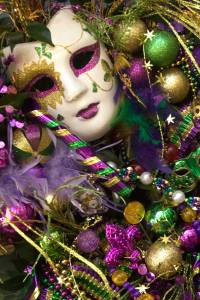This post is the innaugal expose’ of a feature on this blog called What’s It Really Like? People, places, and particular experiences will be exposed for real. De-mystified and debugged. Putting you there for the reality of it all. Start a sentence with. . . have you ever wondered what it’s really like? You get the picture. Enjoy!
Mardi Gras
Most people think that Mardi Gras is about Bourbon Street and boobs. Although in modern times plenty of bourbon and boobs can be experienced on the mad day known as Fat Tuesday, that’s not really what it’s all about.Mardi Gras’ origins can be traced back to the traditions of 17th and 18th century Roman’s in Venice with Carnivale. Its French origins began with the French Bourbons and the “Boeuf Gras” or fatted calf. This celebration followed the French to its new colonies. Point du Mardi Gras was established about sixty miles south of New Orleans on March 2, 1699, when French-Canadian explorer Jean Baptiste Le Moyne Sieur de Bienville landed there. It was given that name by his men who realized they had reached land on the eve of the festive holiday.
In 1704 a French settlement near there established a Masque de la Mobile, named after the two forts there Fort Mobile and Fort Louisiane. The secret society paraded with a large bulls head mounted. In 1710, the “Boeuf Gras Society” was formed and paraded from 1711 until 1861. However, in 1718 Bienville established the city of New Orleans. As was now tradition in the region, Mardi Gras day was celebrated.
The parades that we know today began with the society balls for the occasions which were established by the govenor of Louisiana at the time to benefit various charitable organizations. Festive street processions with masked revelers on carriages and horseback dazzled onlookers with their extravagent costumes and gaslight torches called flambeaux. An exciting air of festive romance and mystique of who was behind the mask was created. The first official Krewe began in 1856 by six young men from Mobile. The Mistick Krewe of Comus rode in on dramatic tableux creating more magic and pageantry. The Krewe still rides today.
Mardi Gras has strong regligious ties. The season actually begins with epiphany, the church’s feast day noting the arrival of the wise men at the birth of Jesus in Bethlehem. On that week, the first parties begin with the king and queen of each krewe being named. A king’s cake of sweet brioche with yellow, green, and purple icing is served. A small replica, traditionally in gold of baby Jesus is baked inside. Whomeve is lucky enough to be served that piece of the cake holds the next party. That tradition continues each week until the day of the parade for that Krewe which culminates in an elaborate ball for the king and queen.
The festivities have grown into an entire multimillion dollar industry for the region. The day before Mardi Gras and the day itself are statewide holidays. Millions crowd the city of New Orleans to attend its parades. The best views of the parades are not down in crowded Bourbon St. but out in the neighborhoods where the parades begin. Street performers, musicians, bands, and elaborate floats can be best enjoyed on St. Charles Avenue, Napoleon, and Carrollton. Krewes such as Endymion, Isis, Zulu and Bacchus maps out their own routes and celebrate their unique theme and philanthropy. To be selected to ride on one of the floats is considered an honor. To be selected as king or queen, sublime. The catch phase by natives is, “Throw me somthing, throw me something Mister.” Or “Miss” as is the case for female Krewe members. There are all kinds of beads, but the most valued are those in yellow symbolizing gold, green for good luck and purple for royalty – especially if you are lucky enough to get a medalion of the Krewe or some of their colorful coins, called deblues.
The season culminates on Fat Tuesday, thus the name Mardi Gras. The day before the solemnity of lent begins. Lent is traditional period of six weeks preparation ending in Holy week which recognizes the events leading to the crucifixtion of Christ, his death and resurrection on Easter. But the day before it all begins, Cajuns and refined Lousiannes Les bon temp roulles. Let the good times roll.
So now, you know what it’s really like. It’s not just about Bourbon and boobs. To enjoy a great story themed with Mardi Gras of the 1960s check out Flying Solo.


You must be logged in to post a comment.